
* In the 1960s, the US Air Force initiated a program to develop an advanced strike aircraft, which emerged as the General Dynamics "F-111". After a troublesome development process, the F-111 became an impressive combat asset, providing excellent service to both the US and Australian air forces. This document provides a history and description of the F-111. A list of illustration credits follows at the end.
* In June 1960, the US Air Force (USAF) issued "Specific Operational Requirement (SOR) 183", defining a new tactical fighter for the nuclear strike role. SOR 183 specified an aircraft that could operate from unprepared forward airfields and would have an unrefueled range of 6,100 kilometers (3,800 miles / 3,100 NMI). It would be able to fly at Mach 1.2 continuously for 740 kilometers (460 miles / 400 NMI).
One of the major features of the aircraft specified under SOR 183 was that it was envisioned as having "variable geometry" or "swing wings", in which the wings pivoted out in a straight-wing configuration for low-speed flight and pivoted back into a delta-like configuration for high-speed flight. This scheme had been tested by the Bell X-5 and Grumman XF10F-1 Jaguar experimental aircraft in the 1950s, and was at the time a leading-edge concept in aircraft design.
SOR 183 was caught in a holding pattern for the moment, however, because it was an election year; it represented a major development program, and of course would be subjected to scrutiny by any new administration in the White House. John F. Kennedy won the 1960 election and his administration took office in early 1961. His defense secretary, Robert S. McNamara, was determined to promote commonality between the US armed services, a factor that would have a major effect on the Air Force's ambitions.
Roughly in parallel with the USAF SOR 183 requirement, the US Navy had been trying to obtain a fleet interceptor with a heavy load of long-range air-to-air missiles (AAM) to protect fleets from air attack. Douglas had been working on a design for such an aircraft, the Douglas "F6D Missileer", but it had proven unsatisfactory and was canceled in late 1960. In keeping with his push for commonality, on 14 February 1961 McNamara initiated a study to determine if a single aircraft could perform both roles, as well as the "Close Air Support (CAS)" role.
As it turned out, the study showed that it wasn't practical to build a single machine that could do all three tasks, and in May 1961 the CAS requirement was split off into a separate program, which would materialize in the form of the excellent Vought A-7 Corsair II. However, the study did conclude that it was possible, at least in principle, to merge the tactical strike and fleet interceptor roles -- and so, on 7 June 1961, McNamara accordingly ordered development of the "Tactical Fighter Experimental (TFX)" to fulfill those requirements. The USAF was to be in charge of the program.
Although some of McNamara's efforts to promote commonality worked out well -- one of the most significant being the USAF's adoption of the Navy McDonnell F-4 Phantom -- others were troublesome from the outset. It wasn't just a case of interservice rivalries, though that could play a part; it was a simple fact that the different services had different needs and requirements. Neither the Air Force nor the Navy were happy with the "shotgun marriage" over the TFX and protested bitterly, but McNamara insisted.
A request for proposals (RFP) was issued in September 1961, with the aircraft to go into operation in October 1965. Nine manufacturers submitted designs, with those of Boeing and General Dynamics being selected as finalists. The Air Force and Navy preferred the Boeing design, but the contract was awarded to General Dynamics (GD) on 24 November 1962, McNamara arguing that the GD design would be more cost-effective. The aircraft was to be designated the "F-111", with the Air Force variant to be designated "F-111A" and the Navy variant the "F-111B".
Grumman was to work under subcontract to GD to work on the Navy version, developing the F-111B's avionics system and performing final integration and test of the F-111B; Grumman would also build some of the assemblies for the Air Force F-111A. The F-111B was to be armed with the long-range Hughes AIM-54 Phoenix AAM, controlled by a powerful AN/AWG-9 long-range radar system; the aircraft was not intended for dogfighting, the objective instead to be a "missile truck" that could pick off intruders before they ever got within striking distance of a carrier group.
The initial contract specified development of 23 development machines, including 17 USAF F-111A development aircraft, one developmental machine for an "FB-111A" strategic bomber -- more later -- and five F-111B Navy fleet interceptor development aircraft.
* Initial flight of the first USAF F-111A was on 21 December 1964, from the GD plant in Fort Worth, Texas. The initial flight of the Navy F-111B was on 18 May 1965, from the Grumman facility in Bethpage, New York. The development program of the F-111A turned out to be troublesome, afflicted by problems with weight, reliability, the twin Pratt & Whitney (P&W) TF30 engines, and most significantly the engine inlets.
The development program for the F-111B went even more badly. The Navy never became very enthusiastic about the F-111B. Early flight trials of the type led to a Navy report in October 1965 that concluded the F-111B was highly overweight and entirely unsatisfactory. Attempts were made to fix the problems, which had the effect mostly of reducing compatibility with the F-111A from about 80% to only 30%.
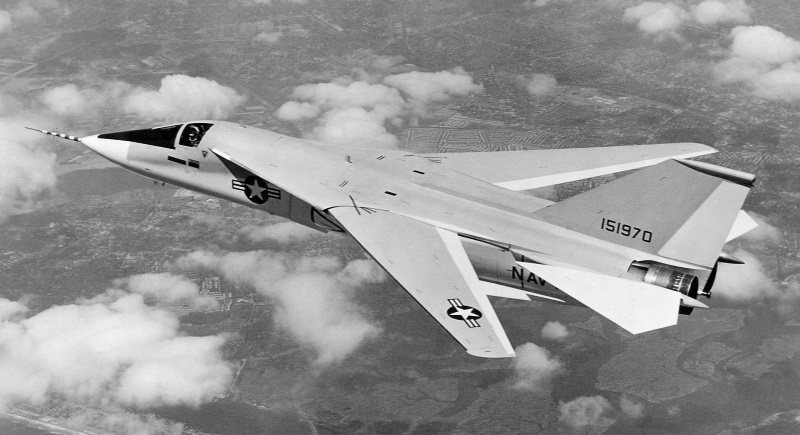
Congress cut funds for the F-111B in May 1968, work was halted in July, and the program was formally axed in December, after the construction of a total of seven F-111Bs, including the five development aircraft and two production machines. Grumman then offered an alternative new design, featuring swing wings, two TF30 engines, Phoenix AAM armament, and the AN/AWG-9 radar, which would eventually emerge as the F-14 Tomcat. In any case, the US Navy had finally got out of the F-111 program. A number of F-111B airframes were put to use in trials; three would be lost in accidents, with four aircrew killed, before the little fleet was retired in 1971.
In the meantime, development of the Air Force F-111 seemed to be going from one hardship to another. The F-111's problems made headline news, the media nicknaming the thing "McNamara's Folly". The whole effort was one of the most controversial and painful aircraft development programs ever. However, the USAF persisted with the F-111A, with first deliveries of production aircraft to the Air Force service in October 1967. It was the first swing-wing aircraft to go into full operational service with any air force.
Interestingly, although the F-111A development program suffered more than its fair share of development problems, it appears that the variable-geometry wing system wasn't particularly troublesome. One F-111 was lost in 1969 when it shed a wing, with the fleet grounded for seven months in consequence, but the accident was traced to shoddy workmanship on the part of a subcontractor and had nothing to do with the design of the wing system; it should be noted that it's not unknown for fixed-wing aircraft to shed a wing, either. Many other swing-wing aircraft would follow the F-111, but on the whole it appears that the benefits of the concept didn't completely outweigh its drawbacks of increased weight and complexity, and it would gradually go out of fashion.
BACK_TO_TOP* The F-111A was a big aircraft, with shoulder-mounted swing wings, a conventional tailplane assembly with all-moving "stabilator" horizontal tailplanes, twin ventral fins, and twin P&W TF30-P-3 afterburning bypass jet engines with 82.3 kN (8,390 kgp / 18,500 lbf) afterburning thrust each.
The swing wings could extend to a minimum sweep of 16 degrees and a maximum sweep of 72.5 degrees -- they could also be set to intermediate positions. The wing position was manually controlled by the pilot using a pistol-grip style controller; an automatic flight control system compensated for shifts in flight trim as the wings changed position. The wings had full-span leading-edge flaps and full-span double slotted flaps, both in four sections. There were no ailerons, with roll control performed by dual spoilers on top of each wing, in front of the two middle flap sections -- the spoilers also serving as lift dumpers for landings. The wings hinged inside fixed leading-edge root extensions or "wing gloves", the outer upper segment of which hinged upward at low speeds as a "vane" to control low-speed airflow.

On the F-111A, when the wings were swept back, the wingtips fell clearly short of the tips of the tailfins; the F-111B had longer-span wings that reached flush to the tips of the tailfins. Apparently there were "ferry tips" that could be attached to the wings of the F-111A and other short-winged variants, but they were rarely if ever used -- not having the bracing of the wing spar, they could snap off fairly easily, and so could only be used for tame ferry flights. The tailplanes, which were set at the same height as the wing, were of "all-moving" configuration, and could be pivoted in alternating directions to perform roll control when the wings were fully swept, the spoilers being disabled in that configuration. There were twin fixed ventral fins under the tail.
The TF30-P-3 engines were mounted side-by-side in the rear fuselage, with the intakes under the wing gloves; the intakes are a complicated subject, of which more is said later. The F-111 didn't have an auxiliary power unit (APU), so starting was either by a ground pneumatic cart, or by pyrotechnic cartridges. Fuel tanks were distributed through the fuselage and in the wings, providing a total fuel load of over 19,000 liters (5,000 US gallons). There was a fuel dump pipe sticking out from between the lower ends of the two exhausts -- which later turned out to be very handy for spectacular airshow displays, dumping fuel and then hitting afterburner to set off a trailing fireball.
* The F-111A featured tricycle landing gear, with the twin-wheel steerable nose gear retracting forward and the single-wheel main gear retracting sideways into the fuselage. The single main gear door also acted as an airbrake. A hydraulically-extended bumper was fitted under the tail to protect the aircraft from scrapes on take-off. There was a midair refueling socket on the back of the aircraft, on the left behind the pilot.
The two crew sat side-by-side, with the pilot on the left and the weapons system officer on the right, under a framed canopy. The crew got in and out via the side windows, each of which hinged up from the center frame. Forward vision was good, rear vision was very poor. The crew did not have ejection seats, with the entire cockpit section breaking free of the aircraft as an "escape capsule", a feature originally included at Navy insistence -- the Air Force had wanted tandem seating with ejection seats. The capsule blasted out of the aircraft using a solid rocket booster, with control flaps to keep it from tumbling. It originally used triple parachutes, though they had an unfortunate tendency to fail in succession; much later they were replaced by a single parachute made of high-strength kevlar polymer.
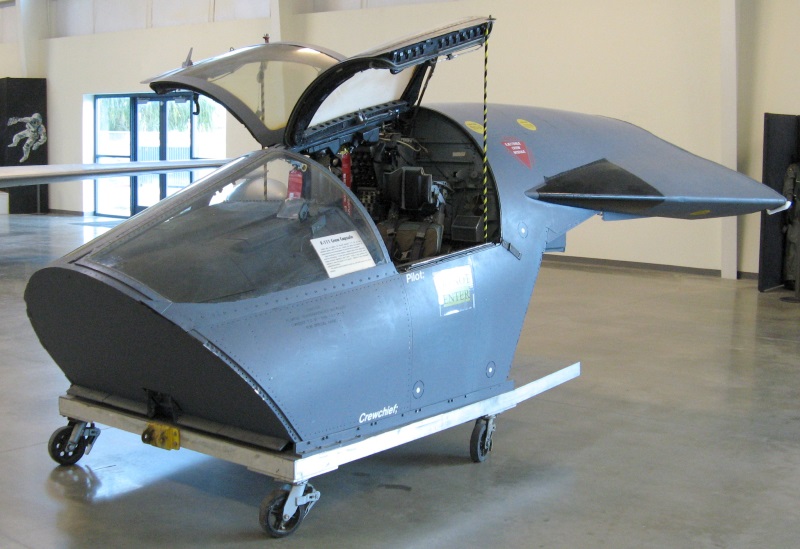
The escape capsule turned out to be problematic. In principle, it permitted safe escapes at speeds that would have dismembered aircrew trying to get out on conventional ejection seats, and it not only floated, thanks to a set of inflatable flotation and impact shock absorber bags, but carried a relatively luxurious kit of survival gear to sustain the crew until they were rescued. The crew also had small survival kits they could pack off with if they came down in hostile territory and had to go on the run.
However, trying to get the heavy and un-aerodynamic capsule to be stable and have an impact speed that didn't kill the crew proved tricky. One F-111 pilot, Merrill McPeak, commented:
BEGIN QUOTE:
The F-111 aircrew ejection system turned out to be much worse than even the complicated Martin-Baker seat in the F-4. Some bright person figured that the crew needed protection during high-speed ejection, but he also decided to make the whole cockpit and a big chunk of structure around it into an escape system, akin to something from the space program. Getting all this separated from the airplane and then deposited safely on land or in water required sequential miracles. I sincerely hoped I'd never have to use it.
END QUOTE
Experience showed it actually was about as safe as ejection seats, though it did land bone-cracking hard. The escape capsule also had to be requalified for operation when the cockpit avionics were modified, a problem not encountered with ejection seats. Incidentally, the escape capsule hadn't been ready in early development, and so early test machines had been fitted with ejection seats.
The combination of side-by-side seating and the set-back air inlets led to one of the worst of the F-111's development problems, since it resulted in a configuration that tended to stagnate airflow to the engines, leading to flame-outs and possibly loss of the aircraft. Inlet design would prove to be something of a cross to bear for GD engineers. The basic inlet configuration was of a quarter-circle configuration, with a conical moving intake cone in the top inner corner, the inlets being positioned under the wing gloves. The intake design was repeatedly changed in efforts to fix airflow problems:
Early TF30s were also regarded as suffering from inadequate thrust -- and they required a fair amount of babying to keep them flying right, leading to a set of upgrades. Apparently the F-111, which didn't need to do a lot of maneuvering, suffered well less from the quirks of the engine than the TF30-powered F-14 Tomcat fighter. Even with the early engines, the F-111A was still able to cruise at supersonic speeds at high altitude with its wings swept back.
* The F-111A was designed for the low-level strike role. It featured a "terrain following radar (TFR)" system that allowed it to hug the ground, arriving on target with little or no warning to the enemy. It was highly effective, but it took a little getting used to. McPeak commented:
BEGIN QUOTE:
The TFR could be coupled to the autopilot for hands-off, high-speed, low-altitude flight in at night or in bad weather. I actually had to do some of this, and it scared me silly. On autopilot, the aircraft would follow terrain contours at 200 feet and, with the wings swept back, at airspeeds above 500 knots. This was bad enough in weather, which will usually give you a peek at the ground. But black, dark night or, worse, night weather would keep you on the edge of your seat -- which is where you better be, given the then-current state of avionics. Once or twice while auto-TFR-ing at night, I -- no kidding -- saw reflections bounce off dirt on either side, the terrain lit up by the strobing of the aircraft's rotating beacon.
END QUOTE
The TFR system could be programmed with an altitude setting, as well as for severity of maneuvering -- from gentle changes in altitude to follow hills, to a severe roller-coaster ride, only used when penetrating heavily defended airspace.
There were four stores hardpoints under each wing, for a total of eight, but four stores pylons were the usual fit in practice; the inner pair of stores pylons adjusted sweep with the wing, the outer pair did not, meaning the wing couldn't be swept in flight if the outer pylons were fitted. There was also a weapons bay under the fuselage behind the cockpit, another inheritance from Navy involvement, with the weapons bay put to various uses on different F-111 variants. In the F-111A, it could be used to accommodate an M61 Vulcan 20-millimeter Gatling cannon, with a drum containing more than 2,000 rounds of ammunition. It could also be used to store twin long-range fuel tanks with a total capacity of 2,214 liters (585 US gallons), though they were rarely used.

The F-111A's "Mark I" avionics suite included as the primary sensor system the General Electric (GE) AN/APQ-113 radar, a multimode system with some air-to-air capability for self-defense, but unsurprisingly focused on the strike mission. It shared the nose radome with a Texas Instruments AN/APQ-110 TFR system, with two little hemispherical antennas flanking the base of the AN/APG-113 radar dish. The nose radome hinged open to the right for servicing. The primary navigation system was an AN/AJQ-20A inertial navigation system (INS), complemented by a TACAN radio navigation beacon receiver. Defensive countermeasures included:
Of course, the avionics suite also included radios and an identification friend or foe (IFF) system. The F-111B had some different avionics, notably the AN/AWG-9 radar, stored in a shorter nose radome that reduced length by 2.6 meters (8 feet 6 inches) -- apparently the reduced length was also dictated by the need for the F-111B to fit on carrier elevators.
The stores pylons were stressed to each carry a maximum load of 2,265 kilograms (5,000 pounds), but that didn't really imply a total practical warload of 9,070 kilograms (20,000 pounds). In the F-111's initial operational actions, a typical warload for a short-range mission was six 225-kilogram (500-pound) general-purpose bombs on each pylon using multiple ejector racks (MERs), for a total of 24 bombs and a total warload of 5,400 kilograms (12,000 pounds). For a long-range strike mission, a typical warload was twelve 340-kilogram (750-pound) bombs on the inboard pylons, possibly with external tanks on the outer pylons; cluster bombs could be carried instead of general purpose bombs. The F-111A could also carry nukes, typically the B61 tactical nuclear weapon, for example with two in the weapons bay. Less malevolent stores included the MXU-648 baggage pod, which was an old napalm tank fitted with a door, used for hauling personal luggage during a transfer to a remote airfield.
All the pylons were "wet", capable of carrying external tanks, which were invariably streamlined low-drag 2,271-liter (600-US gallon) tanks. It is actually a little unusual, though not rare, to find photos of F-111s carrying external tanks, since the aircraft's hefty fuel capacity gave it fairly good range without them.
The F-111A didn't have an excess of engine power, but flying at altitude in clean configuration with the wings swept back it was very fast, over Mach 2 -- the top speed being more limited by airframe tolerance than by propulsion and aerodynamics. Operationally, the F-111A usually didn't break Mach 1, cruising with wings extended and then sweeping them back for a low-level run at high subsonic speed, flying at altitudes less than 300 meters (1,000 feet), and running in to the target area at altitudes of less than 100 meters (330 feet). The F-111A could actually well exceed Mach 1 at low level, producing a shockwave that would leave ruin in its wake -- a tactic that was never adopted because of its complete lack of discrimination.
The relatively small wing area -- about half as great proportional to weight as a McDonnell Douglas F-15 Eagle -- made for a smooth low-level ride, though it meant limited maneuverability as well. An F-111 could be also employed as a "strike leader" for high-altitude bombing, directing a set of other bomb-laden aircraft such as F-4s, which would drop their bombs when cued by the F-111. It is unclear if the F-111 was ever employed in this way in combat, however.
___________________________________________________________________
GENERAL DYNAMICS F-111A:
___________________________________________________________________
wingspan (spread):
19.2 meters (63 feet)
F-111B wingspan (spread):
21.3 meters (70 feet)
wingspan (swept):
9.74 meters (32 feet)
wing area (spread):
61.07 sq_meters (657.1 sq_feet)
wing area (swept):
48.77 sq_meters (525 sq_feet)
length:
22.40 meters (73 feet 6 inches)
F-111B length:
20.98 meters (68 feet 10 inches)
height:
5.22 meters (17 feet 1 inch)
empty weight:
21,393 kilograms (47,172 pounds)
MTO weight:
44,829 kilograms (98,850 pounds)
max speed at altitude:
2,340 KPH (1,455 MPH / 1,265 KT)
service ceiling:
17,680 meters (58,000 feet)
range, internal fuel:
4,280 kilometers (2,660 MI / 2,315 NMI)
___________________________________________________________________
The F-111 was very easy to pilot, described as "outstanding", a "joy to fly"; it wasn't agile but it was fast, and it gave a smooth and impressive ride down on the deck. Its engine-out handling left something to be desired, the surviving engine having to be run on afterburner to keep the aircraft flying. It was very difficult to spin, a pilot had to "really do something crazy" to make it depart proper flight -- but once it did, there was little hope of recovering, and doctrine was to punch out immediately.
* 141 F-111As, not counting the 18 developmental machines, were built for the USAF Tactical Air Command (TAC), with final delivery in August 1969 -- 42 F-111As were later converted to "EF-111A" countermeasures aircraft, as discussed later. Six F-111As were sent to Takhli Air Force Base in Thailand under the COMBAT LANCER program to begin combat missions in March 1968. The colors adopted for the aircraft consisted of a disruptive pattern of brown and two shades of green on top, with white on the bottom; later the bottom would be painted black, judged more suitable because the F-111 was generally a "night fighter". F-111s would serve in variations on disruptive camouflage schemes through most of their career with the Air Force.
COMBAT LANCER did not go well. Three F-111As were lost on missions within four weeks; by the end of April 1968 the type had been withdrawn from combat, pending investigation and resolution of the problems that had caused the losses. The problems were resolved through a modification program codenamed HARVEST REAPER, and in September 1972 48 F-111As were sent into combat as part of the LINEBACKER and LINEBACKER II air campaigns. For all the difficulties, the type finally seemed to be achieving its potential, with the F-111As performing low-level pinpoint strikes on heavily-defended targets.
The F-111As performed more than 4,000 sorties over seven months, with the loss of six aircraft, an acceptable loss rate. They streaked in so fast that the enemy didn't know they were under attack until the bombs went off. One F-111 aircrew who was shot down and taken prisoner recollected later how a North Vietnamese guard told him: "You F-111 ... " -- and then slashed his hand fast sideways: "WHOOSH!"
Although it is hard to always believe the nicknames given aircraft in aviation literature, the F-111A's nickname is well established: "Aardvark", given for its long-nose appearance. Mutations of this name included "Vark" and "Earth Pig" or just "Pig".
BACK_TO_TOP* A number of variants followed the F-111A, featuring a confusing sequence of variant designations. The "F-111E", which despite its designation was the direct successor of the F-111A, was basically similar to the F-111A, with the Mark I avionics system and the TF30-P-3 engines, but significantly featured improved "Triple Plow II" inlets -- largely redesigned, with no moving cowl but three bypass inlet doors on the side of each engine nacelle, as well as more intake area and more separation from the fuselage. 94 F-111Es were built, with most of them spending their service career flying for TAC out of Upper Heyford AFB in the UK.
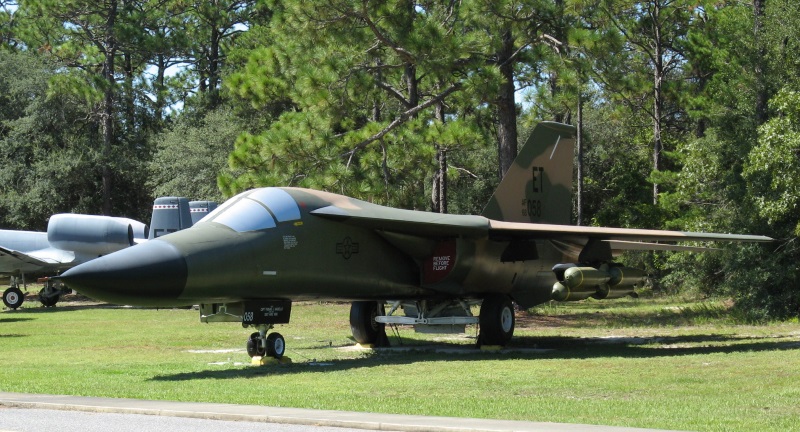
The "F-111D" was in principle a step up from the F-111E, featuring uprated TF30-P-9 engines with 87.2 kN (8,900 kgp / 19,600 lbf) afterburning thrust, stronger landing gear, and a generally revised Mark II avionics system, including:
96 F-111Ds were built, but the machine was simply too ambitious, attempting to accomplish feats that were a generation ahead of time. In fact, the reason for the out-of-sequence production of the F-111E was because development of the F-111D stretched out badly, and so the Air Force obtained F-111Es as an "interim solution". The F-111D also proved troublesome in operation, acquiring a reputation as a "hangar queen", with the "D" in the designation being read as "Dog". Avionics systems were given running updates to improve operational reliability. Most F-111Ds served with the USAF 27th Tactical Fighter Wing at Cannon AFB, New Mexico, until their retirement in late 1992.
* The last and most satisfactory of the USAF's tactical Aardvarks was the "F-111F", which featured TF30-P-100 engines with 111.2 kN (11,335 kgp / 25,000 lbf) thrust each -- about a third more powerful than the early TF30-P-3 engines -- and a "Mark IIB" avionics suite derived from that of the FB-111A, also discussed later. The TF30-P-100s were regarded as the first really acceptable variants of the engine, not merely providing plenty of thrust but also more reliable than earlier variants.
___________________________________________________________________
GENERAL DYNAMICS F-111F:
___________________________________________________________________
wingspan (spread):
19.2 meters (63 feet)
wingspan (swept):
9.74 meters (32 feet)
wing area (spread):
61.07 sq_meters (657.1 sq_feet)
wing area (swept):
48.77 sq_meters (525 sq_feet)
length:
22.40 meters (73 feet 6 inches)
height:
5.22 meters (17 feet 1 inch)
empty weight:
21,537 kilograms (47,481 pounds)
MTO weight:
45,350 kilograms (100,000 pounds)
max speed at altitude:
2,655 KPH (1,650 MPH / 1,435 KT)
service ceiling:
18,290 meters (60,000 feet)
range, internal fuel:
4,710 kilometers (2,925 MI / 2,545 NMI)
___________________________________________________________________
The Mark IIB avionics suite was less capable but cheaper and more reliable than the Mark II suite, featuring the workable parts of the Mark II system, some elements of the Mark I system, and some new kit:
It appears that the old AN/ALQ-94 jammer was updated to the AN/ALQ-137 jammer in service, with this update possibly being provided to other F-111 variants still flying with the USAF. F-111s were given other upgrades, for example encrypted communications and incremental updates for the TF30 engines to improve reliability and handling.
The F-111F was unique among USAF F-111 variants in carrying the AN/AVQ-26 Pave Tack targeting pod, fitted in the F-111F weapons bay, being rotated to be extended for an attack. It was a cigar-shaped pod with a turret on the rear end, featuring a forward-looking infrared (FLIR) camera boresighted to a laser target designator. It was used for targeting laser-guided bombs, with the WSO guiding the munitions with a cockpit display and a joystick. The rear-mounted turret configuration permitted the WSO to keep an eye on the target as the F-111 departed the target area. The mounting in the weapons bay considerably reduced the drag of the big pod.

The F-111F could also carry two 900-kilogram (2,000-pound) GBU-15 cruciform-wing glide bombs, the GBU-15 being an electro-optic guided bomb (EOGB). It had an imager in the nose that viewed a target, with the image fed to the WSO's station. The WSO picked out a high-contrast element in the target image and then, after release, the EOGB would seek the target. The Pave Tack pod was not useful with the EOGBs, with the munitions instead linked to the F-111F via an AN/ASQ-14 or the later ZSW-1 datalink pod on the rear fuselage stores station, with a jammer pod hauled on the forward fuselage stores station.
106 F-111Fs were built, the last delivered in 1976, being the final new-construction F-111 machines produced. Initial deliveries of the F-111F were to Mountain Home AFB in Idaho, but from 1977 to 1992 these aircraft operated from Lakenheath in the UK. They were generally fitted for attack carrying the Pave Tack pod; four 900-kilogram (2,000-pound) or smaller Paveway laser-guided bombs (LGB) on the underwing pylons; and two AIM-9 Sidewinder AAMs for self-defense, mounted on "shoulder" pylons fitted to the side of the outboard main stores pylon on each wing. It appears that Sidewinders didn't become an "official" store until the early 1980s, and at that time the Vulcan cannon was removed from F-111s still fitted with it.
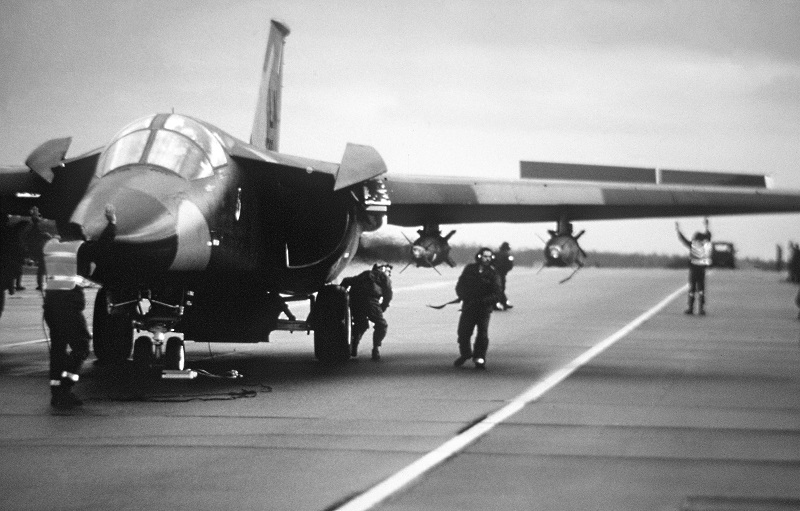
UK-based F-111s served with distinction in Operation EL DORADO CANYON, the US retaliation raid on Libya for the bombing of a Berlin discotheque by Libyan operatives. The operation took place on 14:15 April 1986, performing precision attacks with LGBs. 20 F-111Es, 24 F-111Fs, and five EF-111As were committed to the operation. The F-111Es were kept in reserve, with the F-111Fs performing the strikes, hitting their targets just after midnight, and dropping a total of 54 tonnes (60 tonnes) of munitions. One F-111F was lost to Libyan air defenses in the attack.
F-111s also played an important role in the first Gulf War in 1991, with three F-111F tactical fighter squadrons and parts of a fourth deployed to Taif Air Base in Saudi Arabia, plus a number of F-111Es sent to operate out of Incirlik in Turkey. Four EF-111As were sent to Taif as well. The Aardvarks flew a large number of sorties, being credited with the destruction of hundreds of Iraqi vehicles and artillery pieces. They also carried the new GBU-28 "bunker-buster" LGB, which proved devastating in selective attacks on Iraqi command centers. None of the F-111s were lost in combat.
After the conflict, the F-111s were finally repainted in overall gray colors more typical of Air Force machines like the F-15 Eagle, but by that time the F-111 was nearing the end of the road. Given the defense drawdown of the early 1990s in the wake of the end of the Cold War, the F-111 was judged redundant to needs after the first Gulf War, with the strike machines retired by 1995.
BACK_TO_TOP* The FB-111A, mentioned earlier, was the USAF Strategic Air Command (SAC) variant. The Air Force had been looking around for a successor to the Boeing B-52, with the successor eventually emerging as the Rockwell B-1B, but the path from here to there was complicated and protracted, and so the F-111 was seen as the basis for an interim strategic bomber solution. On consideration of proposals submitted from 1963, SAC authorized development of the FB-111A as a minimally-modified version of the F-111A in 1965.
The single FB-111A developmental machine performed its initial flight in 1967, leading to initial flight of a production FB-111A on 13 July 1968 and introduction to operational service in 1972. The FB-111A was difficult to distinguish from other F-111 variants, differing most visibly in the use of long-span wings as used on the F-111B naval fighter. There were plenty of less visible differences, however, including stronger landing gear as per the F-111D, as well as enhanced brakes unique to the variant, and uprated TF30-P-7 engines with 89.6 kN (9,140 kgp / 20,150 lbf) each. The FB-111A was fitted with the Triple Plow II intakes from the outset.
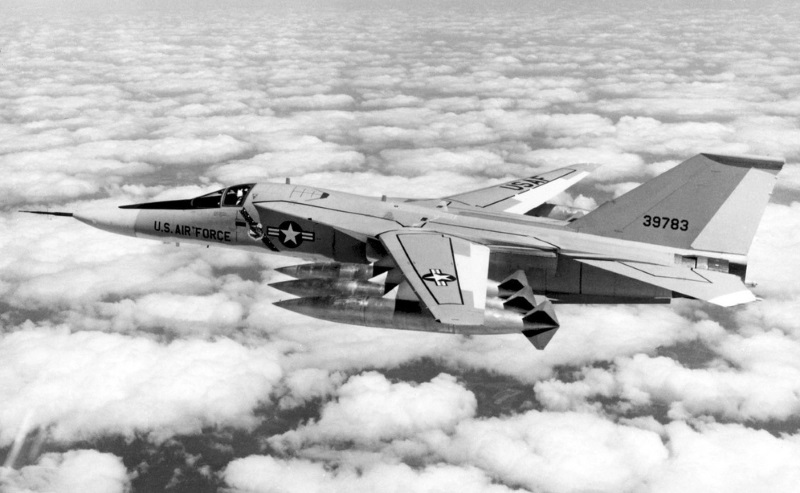
The FB-111A was fitted for the strategic nuclear strike mission, using free-fall nuclear weapons or the Boeing AGM-69 Short Range Attack Missile (SRAM), a relatively small solid-fuel standoff weapon with a range of about 170 kilometers (105 miles / 90 NMI). For short-range missions, the FB-111A could carry four SRAMs, one on each underwing pylon, but for long-range missions, the FB-111A would carry two SRAMs in the weapons bay and use the four wing pylons for external tanks. It appears that FB-111As were occasionally fitted with a third stores pylon on each wing, giving a total of six -- though just for ferry flights, since the outer pylon didn't pivot with the wing, and so the aircraft could not sweep back its wings. The FB-111A was fitted with different, more sharply swept, wing pylons than the tactical F-111 variants.
The FB-111A featured Mark IIB avionics -- the Mark IIB kit was actually introduced for the FB-111A -- with some custom items added to support the strategic mission, such as a star tracker navigation system, mounted forward of the cockpit; a satellite communications receiver; and an automatic stores release system, replacing the manual stores release system used on other F-111 variants.
A total of 76 production FB-111A machines was built, not counting the single developmental aircraft. Introduction of the Rockwell B-1B bomber in the late 1980s eliminated the need for the FB-111A, and so 51 of them were modified to handle conventional weapons for tactical combat operations, being redesignated "F-111G"; the modification program included a degree of general avionics upgrade. Initial redeliveries of F-111Gs were in 1989; in practice, they were used mostly for training. All had been finally retired from USAF service by 1995.
The Rockwell B-1 bomber had actually been canceled during the Carter Administration, to be resurrected and put into production by the Reagan Administration. In response to the cancellation, GD proposed a modified stretched version of the F-111 with more powerful General Electric F101 afterburning bypass jets. This concept was given the designation "FB-111B". GD also promoted a similar but more capable bomber variant as the "FB-111H" -- but the Rockwell B-1 was revived by the Reagan Administration, and the whole issue of improved F-111 strategic bombers evaporated.

* While the US Air Force was the only American armed service to fly the F-111 operationally, the F-111 was also operated by the US National Aeronautics & Space Administration (NASA), with at least six flown by the NASA Dryden Center in California from 1967 to roughly 1990. NASA first obtained a developmental F-111A in 1967, with the agency working to help General Dynamics and the Air Force work out the bugs with the machine; a second was obtained in 1969, being used to perform handling studies.
An F-111E was obtained in 1973 and used in tests of an electronic "fly-by-wire" engine control system, with one TF30 updated to the new control system. The exercise was named the "Integrated Propulsion Control System (IPCS)" program and was conducted in collaboration with the NASA Lewis (now Glenn) Center in Ohio, the USAF, Boeing, Honeywell, and P&W. The IPCS effort ran into 1976, helping to validate digital engine control systems.
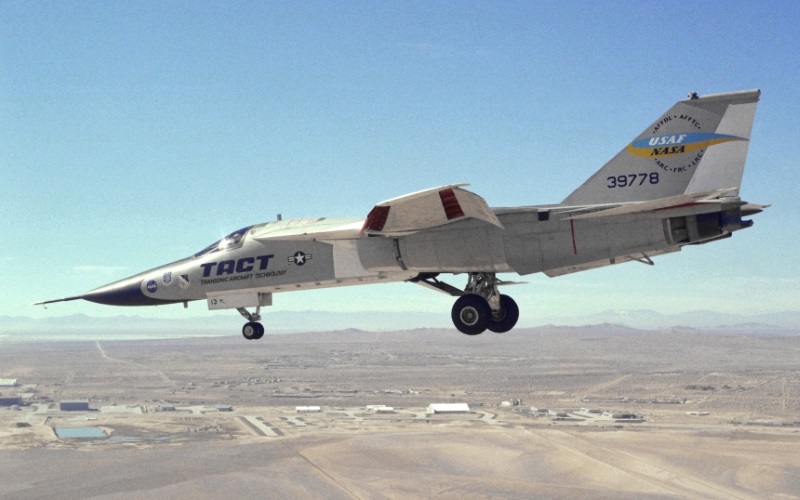
The longest-running NASA F-111 program began in 1971 and featured a developmental F-111A fitted with a new, efficient supercritical wing, the exercise being called the "Transonic Advanced Technology F-111A (TACT/F-111A)". It led to fit of a new advanced wing system -- the "Mission Adaptive Wing (MAW)" that could change its configuration in flight -- in the "Advanced Fighter Technology Integration F-111A (AFTI/F-111A)" effort. The tests were finally terminated in 1988. One F-111E was also used in trials conducted by the Air Force to evaluate a battlefield surveillance radar codenamed PAVE MOVER, with the antenna carried in a large pod under the forward fuselage, strictly as an experimental exercise.
BACK_TO_TOP* During the Vietnam War, the Tactical Air Command had relied on the Douglas EB-66 Skywarrior for the electronic warfare (EW) role, but by the early 1970s the EB-66s were clearly too weary to carry on much longer. The nasty losses taken by the Israelis during the 1973 Yom Kippur War from the latest generation of Soviet surface-to-air missiles (SAM) was a wakeup call to TAC. A new EW aircraft had to be acquired as quickly as possible.
The Navy's excellent EA-6B Prowler and its Eaton/AIL AN/ALQ-99 EW system represented a well-developed solution, but TAC felt the Prowler's speed and range were inadequate, and didn't want to support an aircraft type not in USAF inventory. The idea then came up that retired F-111As could be fitted with the AN/ALQ-99 system. A few analyses and tests demonstrated the idea was practical, and on 26 December 1974, the Air Force awarded Grumman a contract to modify two F-111As accordingly as "EF-111A" aircraft.
An F-111A fitted with a ventral fairing for aerodynamic tests performed the first test flight for the program on 15 December 1976. The first prototype performed its initial flight from Grumman's facility on Long Island on 10 March 1977, fitted with all the fairings for the "production" aircraft, but otherwise not close to spec in terms of equipment fit. The second prototype, which was near production specification, performed its initial flight on 17 May 1977.
A total of 42 EF-111A "Ravens" AKA "Spark Varks" was produced by modification of retired F-111As, with introduction to service late in 1981, and the last delivered in December 1985. The total included the two machines used for development, which were then brought up to operational spec and fielded.
The Ravens originally retained the old TF30-P-3 engines of the F-111A, but featured improved AN/APQ-160 attack radar and AN/APQ-110 terrain-following radar in the nose for flight navigation. The real change, of course, was the AN/ALQ-99E Tactical Jamming System (TJS). The TJS included ten jamming modules and five digitally-tuned signals receivers, all carried in the weapons bay, with a long "canoe" fairing on the bottom to accommodate the jammer transmitting antennas.
A prominent fairing was mounted on top of the tailfin to accommodate the receiving antennas -- the antenna arrangement giving a field of view over all four quadrants around the aircraft -- supplemented by a blade antenna on each side of the fuselage under the wing. There was also a small teardrop receive antenna mounted on the top of each wingroot extension for the AN/ALR-64(V)-4 threat warning system.
The TJS installation on the Raven was much cleaner than that of the Prowler, which carried jammer pods on underwing pylons, and the EF-111A's jamming system was much more automated, with a single electronics warfare officer (EWO) operating the system instead of the three EWOs on the Prowler. The right-hand position for the EWO was modified extensively, with the control column removed and navigation indicators moved to the pilot's side. The EWO had a large video display screen -- a contrast with the older "steam gauge" instrument panel layout for the pilot.
All weapons systems avionics were removed. Empty weight increased by about 10%, but it didn't matter since the EF-111A didn't carry a warload; some sources claim it could carry Sidewinder AAMs for self-defense -- they didn't require much additional gear for carriage, with the missile's seeker emitting a tone to the aircrews' headphones to indicate target lock -- but apparently that was not done in practice. External fuel tanks and datalink pods could still be hauled on the stores pylons, and they were also used for baggage pods when necessary.

Most of the EF-111As were based at Mountain Home AFB in Idaho, serving with the 390th (earlier 388th) Electronic Countermeasures Squadron (ECS), but 13 were based with the 42nd ECS at RAF Upper Heyford in the UK, which operated F-111 strike variants. The Spark Varks generally flew in overall light gray colors. From 1986, the EF-111As were refitted with more powerful TF30-P-9 engines. From 1989, they were fitted with the "Avionics Modernization Program (AMP)" kit, which included:
As mentioned above, the Spark Varks participated in Operation EL DORADO CANYON in 1986, and performed with distinction in the Gulf War in 1991 -- though one was lost with its crew in an accident in that conflict. The Air Force hoped to keep the EF-111A in service well into the 21st century; a program to update the jamming systems was initiated in 1991, but funding cuts during the 1990s forced the USAF to change plans, and the last EF-111As were retired on 1 April 1998, ending the F-111's tour of duty with the USAF. Ironically, the Air Force was forced to rely on the EA-6B for the jamming mission; the USAF is still searching around for a next-generation countermeasures platform strategy.
BACK_TO_TOP* The US was enthusiastic about the prospects of the F-111 in the early years of development, with consideration of export sales. The British government was interested enough in the concept to scrap development of their own comparable low-level strike aircraft, the BAC TSR-2, which was seen as too expensive, and order a Briticized version of the F-111 for the Royal Air Force (RAF) designated the "F-111K". It was to be similar to the FB-111A, and in fact it appears F-111K development preceded that of the FB-111A. 50 F-111Ks were to be obtained by the RAF, including 4 "TF-111K" trainers.
Unfortunately, schedules slipped out, costs ballooned, and the F-111K gradually became too expensive as well, leading to cancellation of the program. The cancellation was a setback for the Americans, and a bigger setback for the British government, which came under severe public criticism for the fiasco. The RAF ended up settling for a version of the Royal Navy's Blackburn Buccaneer shipboard strike aircraft, which in some compensation provided outstanding service over a career lasting decades.
As a result, the only export user of the F-111 was Australia, which needed a replacement for their aging English Electric Canberra attack aircraft. The first of an initial batch of 24 "F-111Cs" was delivered in 1973 after a certain amount of confusion, delay, and pain; the Americans loaned the Aussies 24 McDonnell F-4 Phantoms as an interim solution until the F-111Cs could be delivered. The F-111C was an expensive solution, but the Royal Australian Air Force (RAAF) needed a highly capable strike aircraft capable of operating over the long expanses of the South Pacific; the F-111 fit the bill.
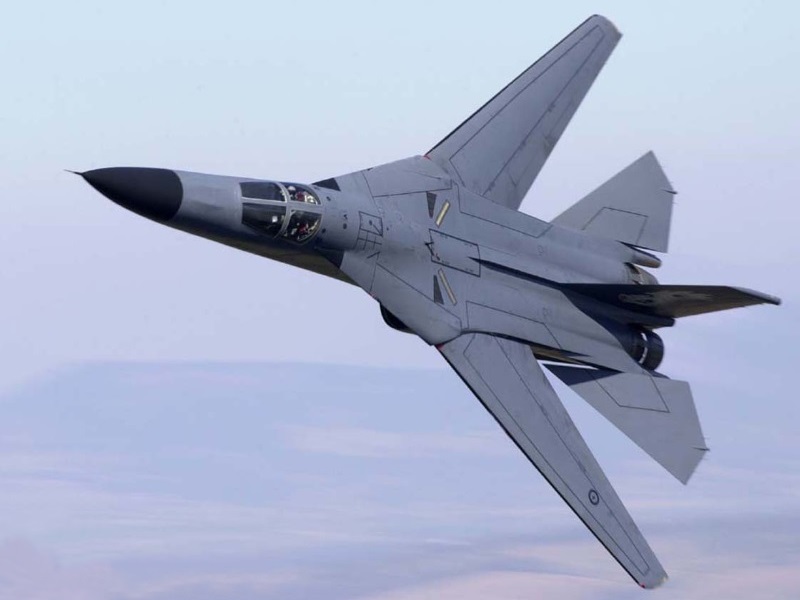
The F-111C was essentially an F-111A fitted with the longer wings of the FB-111A and the stronger undercarriage of the F-111D. Four ex-USAF F-111As were later obtained by Australia as attrition replacements, with the aircraft refurbished and brought up to F-111C standard, and in the 1990s the RAAF also acquired 15 retired F-111Gs to keep their fleet up to strength.
The Aussie F-111 fleet received substantial upgrades in service:
While the F-111Cs were delivered in disruptive "jungle camouflage" colors, in the early 1990s they were repainted in a tidier overall gray color. The Aussie F-111s had unique weapons fits, including carriage of the AGM-84 Harpoon antiship missile and the Israeli Popeye glide bomb. They were qualified for carriage of the AGM-88 HARM antiradar missile, but it wasn't procured.
When Australia led a peacekeeping force into East Timor in 1999 to restore order after a fractious independence vote, the RAAF used their RF-111Cs to keep track of Indonesian Defense Force movements and to locate bands of refugees hiding in the hills. The last Aussie F-111 machines were finally retired in late 2010, being replaced by the Boeing F/A-18E/F Super Hornet.
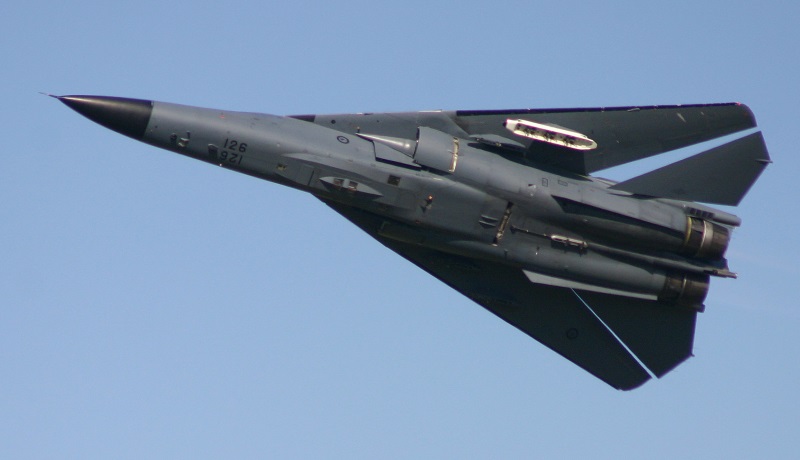
There was loud wailing over this decision from Australian fans of the F-111, claiming that the "Super Bug" was in no way an adequate substitute for the F-111; to be sure, the ancient F-111Cs had become a gross maintenance headache, but the type's defenders believed the money might be better spent just overhauling and upgrading old F-111s retrieved from mothballs in the US, instead of on the F/A-18E/F. The Australian government did not agree, and so the F-111 was finally phased out of service.
*A total of 562 F-111s was built, the breakdown by variant being as follows:
* As a footnote to the F-111 story, the Soviets developed a swing-wing strike aircraft, the Sukhoi Su-24 "Fencer", with considerable similarities to the F-111, and the tale still lingers that the Su-24 was a direct imitation of the F-111. A close examination of the Su-24's development history shows that not true: as mentioned earlier, variable geometry was something of a fad in the 1960s, with a number of aircraft built all over the world featuring the technology. Certainly the Soviets thought the F-111 was a good idea worth emulating, but the basic airframe of the Su-24 actually evolved from the Su-15 "Flagon" long-range interceptor -- and though the F-111 and the Su-24 had strong similarities at a configurational level, they were entirely different at the detail level.
* The F-111 is fairly well documented, and as a result this article is likely fairly accurate. It was nice to find production quantities that seemed reliable -- though obnoxiously, while all sources I consulted agree on the number of each F-111 variant built, some give cumulative totals such as 566. I triple-checked my numbers and I kept coming up with 562. Exactly which value is correct is one question, but at least sources could have agreed with themselves.
I have only seen an F-111 once in flight, but it was very impressive. I was stationed in Germany in 1974:75 with the US Army Signal Corps, and one wintry day I was on top of a signal tower on a hill with a likeably crusty NCO named Schadle, being cut to ribbons by a razor-cold winter wind. Sergeant Schadle looked out over the gray overcast countryside and said: "Look at that." I looked out myself and finally saw a tiny object skating over the hilltops towards the horizon.
"What is it?"
"It's an F-111". I couldn't make out any details, it was too far away, but there was nothing else that could fly like that. I still remember it clearly, and also remember how morosely gray the day was and how $%!k#*$ cold I was.
* Sources include:
Some comments were also obtained from the extensive aviation website built by aviation enthusiast Joe Baugher. Comments on the NASA use of the F-111 were obtained from the NASA Dryden webpage. One F-111 aircrew contacted me to say Merrill McPeak's reports of being frightened by TFR were overblown, to which I could only reply: "It would frighten ME!" And I like thrill rides!
* Illustrations details:
* Revision history:
v1.0.0 / 01 nov 10 v1.0.1 / 01 oct 12 / Review & polish. v1.0.2 / 01 jun 14 / Review & polish. v1.0.3 / 01 may 16 / Review & polish. v1.0.4 / 01 may 18 / Review & polish. v1.0.5 / 01 apr 20 / Review & polish. v1.0.6 / 01 jan 22 / Review & polish. v1.0.7 / 01 feb 23 / Review & polish. (+)BACK_TO_TOP
